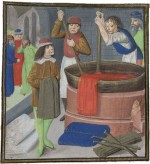 The beautiful red colors produced by vegetable dyes have a richness and mellowness that can’t be achieved with chemical dyes. These many shades of red can be produced by a variety of herbs that are good additions to a dye garden. Some of the herbs can produce other colors too, depending on the mordant used to fix the color to the fabric. Even if you don’t plan to use the plants to dye textiles, it is fun and interesting to include the plants in an herb garden.
The beautiful red colors produced by vegetable dyes have a richness and mellowness that can’t be achieved with chemical dyes. These many shades of red can be produced by a variety of herbs that are good additions to a dye garden. Some of the herbs can produce other colors too, depending on the mordant used to fix the color to the fabric. Even if you don’t plan to use the plants to dye textiles, it is fun and interesting to include the plants in an herb garden.
Here are five herbs that can produce a shade of red. Information is given for wool, the fabric most commonly dyed with vegetable dyes at the present time. Other fibers may act differently.
 Lady’s Bedstraw (Galium vernum)
Lady’s Bedstraw (Galium vernum)
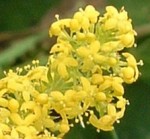 The roots of this tall, erect herb produce many shades of red depending on the mordant. With an alum mordant, a true red; with a chrome mordant, a purplish red; and with a mix of alum and chrome mordants, a light orange red. Be prepared to collect a lot of roots.
The roots of this tall, erect herb produce many shades of red depending on the mordant. With an alum mordant, a true red; with a chrome mordant, a purplish red; and with a mix of alum and chrome mordants, a light orange red. Be prepared to collect a lot of roots.
-
Type: Perennial
Height: 3’
Bloom: Dense clusters of small yellow flowers in late summer
Light: Full sun to light shade
Soil: Rich, light, well-drained
Hardiness: Zones 3-10
 Madder (Rubia tinctorum)
Madder (Rubia tinctorum)
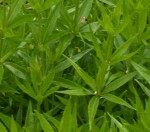 Madder was used in the burial wrappings of Egyptian mummies and it has been used ever since until the nineteenth century when it was replaced by chemical dyes. The roots are used with a alum mordant to produce lacquer red and with a chrome mordant to produced garnet red. Both colors have excellent color fastness. The plant tends to lie on the ground as the stems are weak and flowers are inconspicuous. The main reason for growing the plant is its role in history of vegetable dyes.
Madder was used in the burial wrappings of Egyptian mummies and it has been used ever since until the nineteenth century when it was replaced by chemical dyes. The roots are used with a alum mordant to produce lacquer red and with a chrome mordant to produced garnet red. Both colors have excellent color fastness. The plant tends to lie on the ground as the stems are weak and flowers are inconspicuous. The main reason for growing the plant is its role in history of vegetable dyes.
-
Type: Herbaceous perennial
Bloom: Small inconspicuous flowers in late summer and early fall
Height: 4’
Light: Full sun
Soil: Average, well-drained
Hardiness: Zones 6-8
 Pokeweed (Phytolacca americana)
Pokeweed (Phytolacca americana)
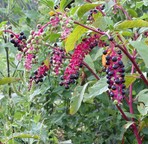 To many gardeners pokeweed is a weed and it is rarely cultivated. It is coarse and large so is best in a large garden but the berries produced in fall are attractive and can be used effectively in flower arrangements. The fresh berries are also important as a source of red dye when used with an alum or tin mordant, but color fastness is only fair.
To many gardeners pokeweed is a weed and it is rarely cultivated. It is coarse and large so is best in a large garden but the berries produced in fall are attractive and can be used effectively in flower arrangements. The fresh berries are also important as a source of red dye when used with an alum or tin mordant, but color fastness is only fair.
-
Type: Bushy herbaceous perennial
Flower: Clusters of small, white to purplish flowers in summer
Height: 4-9’
Light: Full sun to partial shade
Soil: Humus rich, moist
Hardiness: Zones 2-10
 Potentilla (Potentilla verna)
Potentilla (Potentilla verna)
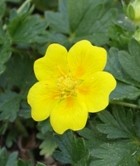 A relative of roses, potentilla, are attractive low growing plants with strawberry plant-like leaves and bright yellow flowers in spring. The plants spread rapidly and produce a dense mat. Fresh roots produce brown-red with a chrome mordant, and purple-red with an iron mordant.
A relative of roses, potentilla, are attractive low growing plants with strawberry plant-like leaves and bright yellow flowers in spring. The plants spread rapidly and produce a dense mat. Fresh roots produce brown-red with a chrome mordant, and purple-red with an iron mordant.
-
Type: Herbaceous perennial
Bloom: Bright yellow flowers in spring to early summer; long lasting
Height: 3-6”
Light: Sun to part shade
Soil:Average, well-drained
Hardiness: Zones 4-8
 Sweet Woodruff (Galium odoratum)
Sweet Woodruff (Galium odoratum)
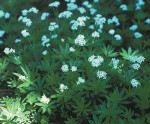 This charming herb traditionally used to flavor May wine offers apple green foliage and masses of tiny white flowers in spring. It loves the shade of a woodland where it quickly spreads and makes a beautiful groundcover. Fresh roots produce red when used with an alum mordant.
This charming herb traditionally used to flavor May wine offers apple green foliage and masses of tiny white flowers in spring. It loves the shade of a woodland where it quickly spreads and makes a beautiful groundcover. Fresh roots produce red when used with an alum mordant.
-
Type: Herbaceous perennial
Bloom: Loose branching cymes of small white flowers in spring
Height: 5-12”
Light: Shade
Soil: Humus-rich, moist, well-drained
Hardiness: Zones 6-10
Using these five different plants with different mordant could result in a large range of reds. Madder and Lady’s bedstraw are the two most important sources of red dye but the charm of sweet woodruff makes it well worth growing too. Pokeweed is so ubiquitous, you hardly need make the effort to grow it but it has its place in the dye garden.
